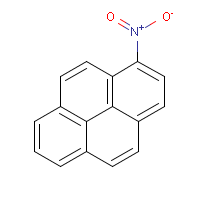SILENT SPRING INSTITUTE
Environment and Breast Cancer: Science Review
www.silentspring.org/sciencereview
Environment and Breast Cancer: Science Review
www.silentspring.org/sciencereview
1-nitropyrene
CAS RN 5522-43-0
CAS RN 5522-43-0
Originating list
Carcinogenicity Potency Database, IARC Monographs, National Toxicology Program 11th Report on Carcinogens, Chemical Carcinogenesis Research Information System
Carcinogenicity Potency Database, IARC Monographs, National Toxicology Program 11th Report on Carcinogens, Chemical Carcinogenesis Research Information System

Image from the National Library of Medicine
Associated chemicals
none
none
Major use
Product of combustion
Product of combustion
Widespread exposure
More Likely
More Likely
Human exposure summary
Diesel exhaust is considered the major source of exposure to nitro-PAHs such as 1-nitropyrene. Monitoring data indicate that the general population may be exposed to 1-nitropyrene and other nitro PAHs via inhalation of ambient air, ingestion of food and drinking water, and dermal contact. 1-nitropyrene is one of the most abundant mononitroarenes detected in ambient air (NTP 11th ROC).
Diesel exhaust is considered the major source of exposure to nitro-PAHs such as 1-nitropyrene. Monitoring data indicate that the general population may be exposed to 1-nitropyrene and other nitro PAHs via inhalation of ambient air, ingestion of food and drinking water, and dermal contact. 1-nitropyrene is one of the most abundant mononitroarenes detected in ambient air (NTP 11th ROC).
Mammary gland tumor summary
In studies listed in CPDB and NTP 11th ROC, five of eight studies report increased benign and/or malignant mammary tumors from dosing. NTP 11th ROC: When administered by subcutaneous injections, 1-nitropyrene induced mammary tumors (including adenocarcinomas) in female rats. A study in female rats injected intraperitoneally with 1-nitropyrene showed increased mammary tumors; a second intraperitoneal study demonstrated a nonstatistically significant increase in mammary tumors. Mammary gland tumors were also increased following oral administration of 1-nitropyrene to female rats.
In studies listed in CPDB and NTP 11th ROC, five of eight studies report increased benign and/or malignant mammary tumors from dosing. NTP 11th ROC: When administered by subcutaneous injections, 1-nitropyrene induced mammary tumors (including adenocarcinomas) in female rats. A study in female rats injected intraperitoneally with 1-nitropyrene showed increased mammary tumors; a second intraperitoneal study demonstrated a nonstatistically significant increase in mammary tumors. Mammary gland tumors were also increased following oral administration of 1-nitropyrene to female rats.
Risk assessment summary
Diesel exhaust is considered the major source of exposure to nitroPAHs such as 1,8-dinitropyrene. Despite the fact that many nitroarenes (as well as PAHs) have been consistently shown to cause mammary gland tumors, the US EPA IRIS record on diesel exhaust(1) does not mention mammary gland tumors or breast cancer and US EPA's 669-page Health Assessment Document for Diesel Exhaust (2) focuses exclusively on lung cancer, not discussing the potential for breast cancer. In contrast, risk assessments by IARC (3), the World Health Organization (4) and the NTP Report on Carcinogens (5) include discussion of mammary gland tumors. A search of PubMed for "diesel exhaust", risk assessment, and "breast cancer" did not produce any articles, and "diesel" with "breast cancer" only brought up two in vitro studies. Cancer risk from diesel exhaust is a major contributor to overall cancer risk from air pollution -- for example the California Air Resources Board has estimated that 70% of cancer risk from toxic air pollution is due to diesel exhaust (focus is lung cancer) (6). Most of the carcinogenic risk of diesel exhaust is estimated to come from PAHs, rather than nitroPAHs (4).
Diesel exhaust is considered the major source of exposure to nitroPAHs such as 1,8-dinitropyrene. Despite the fact that many nitroarenes (as well as PAHs) have been consistently shown to cause mammary gland tumors, the US EPA IRIS record on diesel exhaust(1) does not mention mammary gland tumors or breast cancer and US EPA's 669-page Health Assessment Document for Diesel Exhaust (2) focuses exclusively on lung cancer, not discussing the potential for breast cancer. In contrast, risk assessments by IARC (3), the World Health Organization (4) and the NTP Report on Carcinogens (5) include discussion of mammary gland tumors. A search of PubMed for "diesel exhaust", risk assessment, and "breast cancer" did not produce any articles, and "diesel" with "breast cancer" only brought up two in vitro studies. Cancer risk from diesel exhaust is a major contributor to overall cancer risk from air pollution -- for example the California Air Resources Board has estimated that 70% of cancer risk from toxic air pollution is due to diesel exhaust (focus is lung cancer) (6). Most of the carcinogenic risk of diesel exhaust is estimated to come from PAHs, rather than nitroPAHs (4).
IARC classification
2B: Possibly carcinogenic to humans
2B: Possibly carcinogenic to humans
Evidence in humans
NA
NA
Tumor sites identified in IARC Monographs
mammary gland, liver, lung
mammary gland, liver, lung
Evidence in animals
sufficient
sufficient
US EPA cancer classification
NA
NA
Female rats
NA
NA
Female mice
NA
NA
Male rats
NA
NA
Male mice
NA
NA
Mutagenicity from CPDB
NA-S
NA-S
Mutagenicity from RTECS
Mutagenic
Mutagenic


